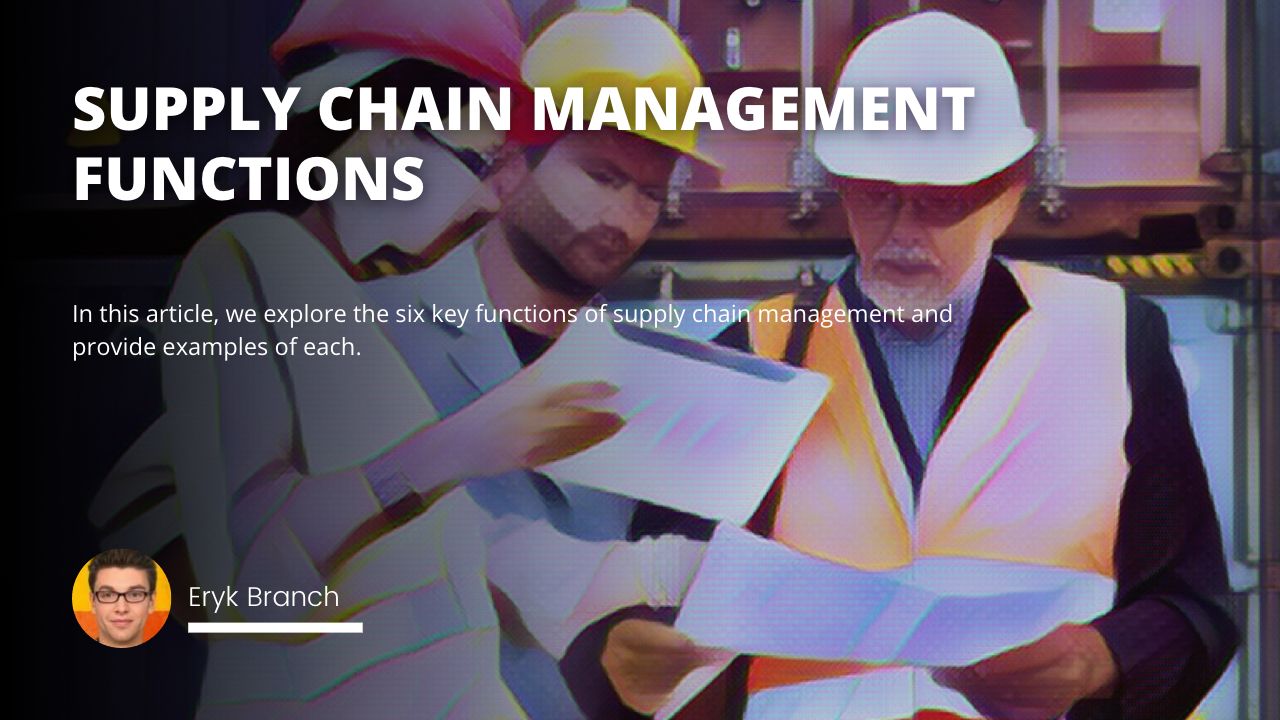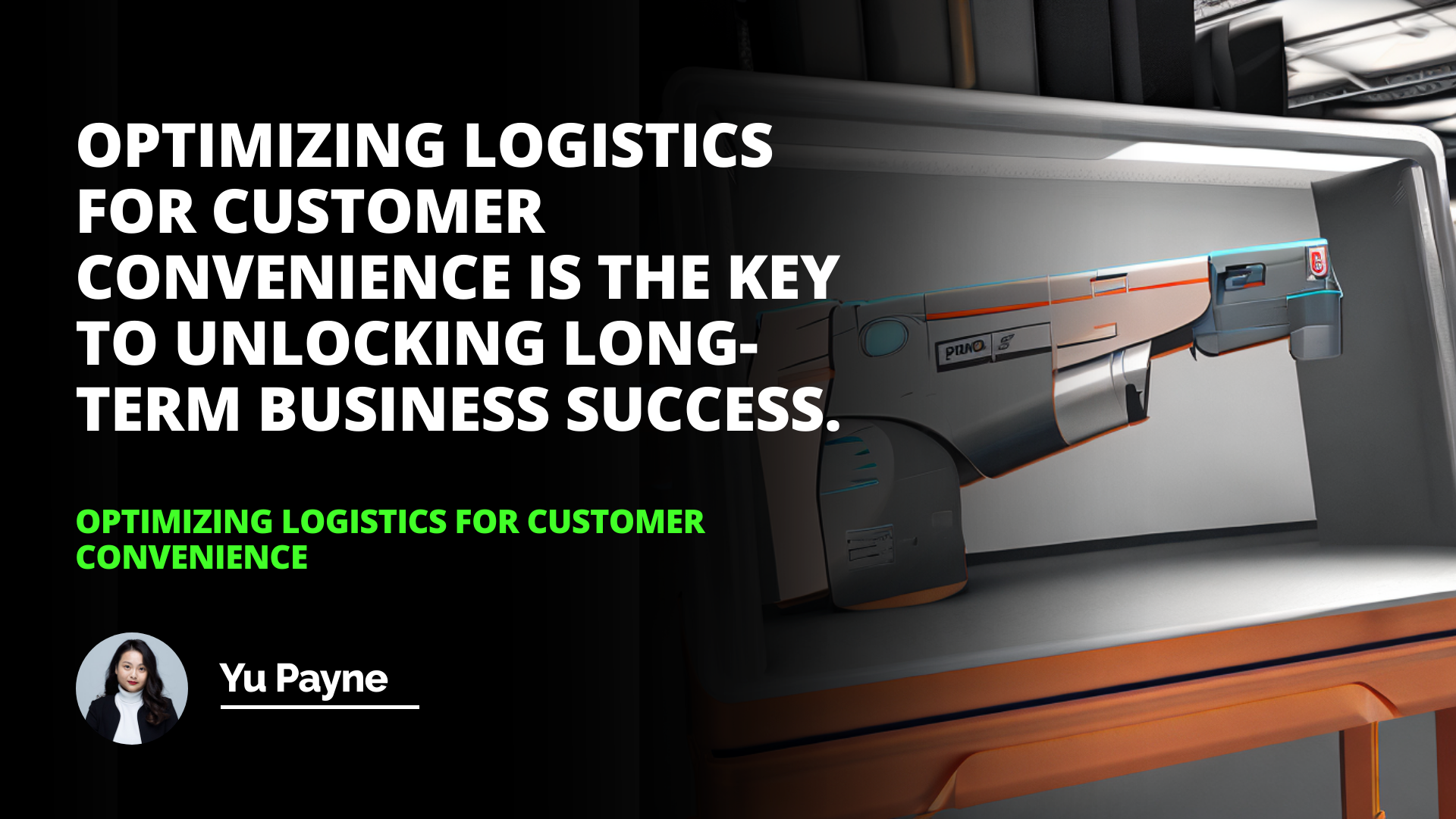
This article discussed the importance of order convenience in customer service and satisfaction. It outlined the barriers to order convenience, such as paperwork, compliance procedures, payment terms, communication networks, and coordination in the supplier's marketing network. It also discussed the impact of these barriers on customers, such as delays in receiving goods or services and decreased sales and customer loyalty.
Finally, it discussed strategies for optimizing logistics for customer convenience, such as streamlining paperwork, simplifying procedures, providing clear payment terms, improving communication networks, and using technology to automate and streamline processes.
Introduction
What is Order Convenience?
Barriers to Order Convenience
Impact of Barriers on Customers
Strategies for Optimizing Logistics for Customer Convenience
Introduction: Order convenience is an essential factor in customer service and satisfaction. It is the ease with which customers can place an order and receive their goods or services. All small and large businesses must ensure that their order convenience processes are as efficient and effective as possible. This article will discuss the barriers to order convenience, the impact of these barriers on customers, and strategies for optimizing logistics for customer convenience.
What is Order Convenience?
Order convenience is the ease with which customers can place an order with a supplier and receive their goods or services. It is essential to customer service and satisfaction, as customers expect a seamless and efficient process when they purchase products or services. Order convenience involves several tasks that must be coordinated in the logistics supply chain. These tasks include paperwork, compliance to procedures, payment terms, communication networks, and coordination in the supplier's marketing network.
Barriers to Order Convenience
Several barriers to ordering convenience can prevent customers from having a smooth and efficient ordering experience. These include paperwork required by the supplier, compliance with various procedures, complex payment terms, poor communication networks at the supplier's end, and poor coordination in the supplier's marketing network. These barriers can lead to opportunity loss and the waning of the customer base in competitive markets.
Impact of Barriers on Customers
The barriers to order convenience can have a significant impact on customers. Customers may experience delays in receiving their goods or services, resulting in frustration and dissatisfaction. Additionally, customers may be discouraged from placing orders due to the complexity of the process or the lack of communication from the supplier. This can lead to a decrease in sales and customer loyalty.
Strategies for Optimizing Logistics for Customer Convenience
To ensure a smooth and efficient ordering process, businesses should strive to optimize their logistics for customer convenience. This can be achieved by streamlining paperwork, simplifying procedures, providing clear payment terms, improving communication networks, and ensuring supplier marketing network coordination.
Additionally, businesses should use technology to automate and streamline processes, such as using an online ordering system or a customer relationship management (CRM) system. These strategies can help businesses ensure customers have a positive ordering experience, resulting in increased customer satisfaction and loyalty.
Conclusion: Order convenience is an essential factor in customer service and satisfaction. To ensure that customers have a positive ordering experience, businesses must strive to optimize their logistics for customer convenience. This can be achieved by streamlining paperwork, simplifying procedures, providing clear payment terms, improving communication networks, and ensuring supplier marketing network coordination.
Additionally, businesses should use technology to automate and streamline processes. By implementing these strategies, businesses can ensure that their customers have a positive ordering experience.
Optimizing logistics for customer convenience is the key to unlocking long-term business success.
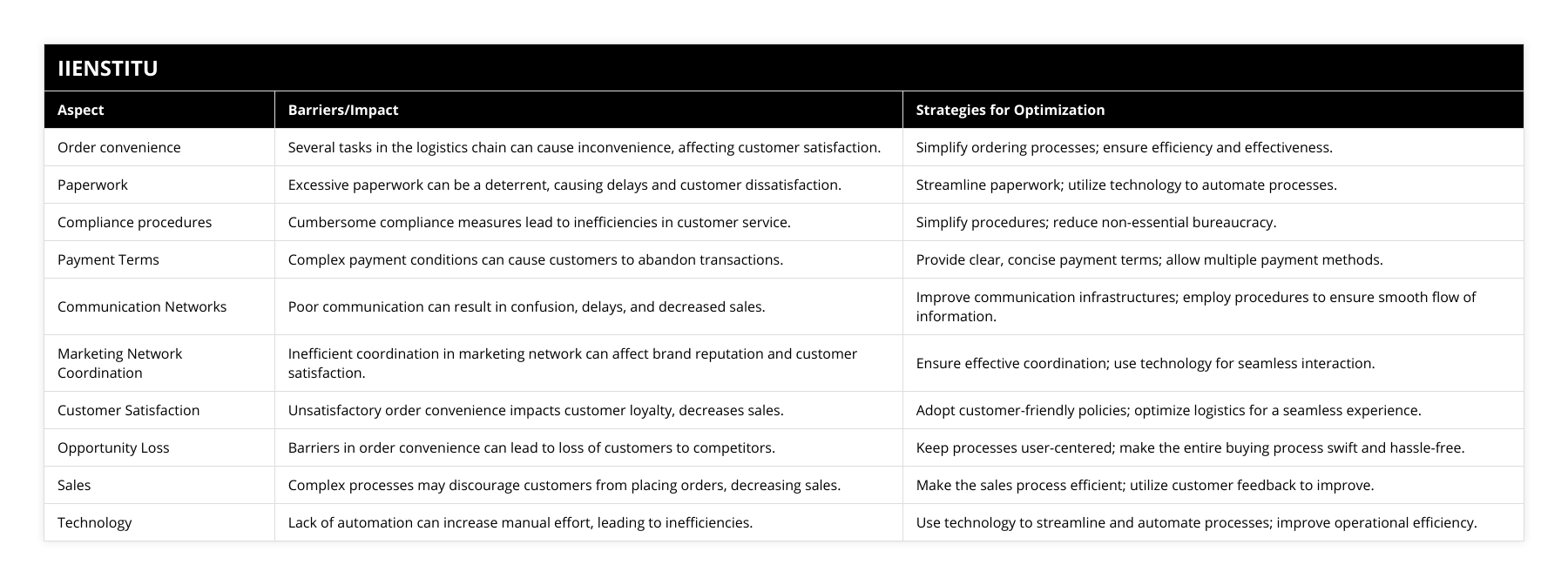
In a nutshell, the article emphasizes the significance of order convenience for customer satisfaction. Various barriers to order convenience, such as complex paperwork, compliance procedures, payment terms, and coordination issues can affect customer experiences, causing delays, reducing sales, and affecting customer loyalty. Therefore, the article suggests strategies such as streamlining the ordering process, leveraging technology, and enhancing communication for optimizing logistics for customer convenience. A deeper understanding of these concepts can be gained through a supply chain management online course with a certificate, where the learner can grasp the essential tools and techniques for effective logistics management.supply chain management online course with certificate
Related Course: Logistics Certification Courses
Frequently Asked Questions
What strategies can be employed to optimize logistics for customer convenience?
Logistics operations are essential to ensure customer convenience and satisfaction. A successful logistics strategy should be designed to ensure the delivery of goods and services in a timely and efficient manner while also considering customer preferences. This article will discuss several strategies that can be employed to optimize logistics for customer convenience.
First, it is essential to identify the customer’s needs and preferences. This can be done through customer surveys, focus groups, and market research to gain insight into the customer’s requirements, preferences, and expectations. This information can then be used to develop a logistics strategy that meets customer needs.
Second, it is essential to establish an efficient delivery network. This includes selecting the correct delivery methods, such as road, rail, air, and sea freight, and evaluating the cost and time involved in each type of delivery. Additionally, it is essential to consider the type of goods being shipped and the customer’s location when selecting a delivery method.
Third, ensuring that the delivery process is streamlined and efficient is essential. This can be done by utilizing technology to automate tasks such as tracking and monitoring shipments, as well as providing customers with real-time updates on the status of their orders. Additionally, it is essential to ensure that the customer has access to customer service representatives who can answer their questions and address any issues that may arise.
Finally, it is essential to use data and analytics to improve processes and optimize the logistics network. Data and analytics can be used to identify areas of improvement, such as reducing delivery times, increasing customer satisfaction, and reducing operational costs. Additionally, they can streamline processes, such as forecasting demand and optimizing inventory management.
By utilizing these strategies, businesses can optimize logistics for customer convenience. This can help businesses to build customer loyalty, increase customer satisfaction, and improve operational efficiency.
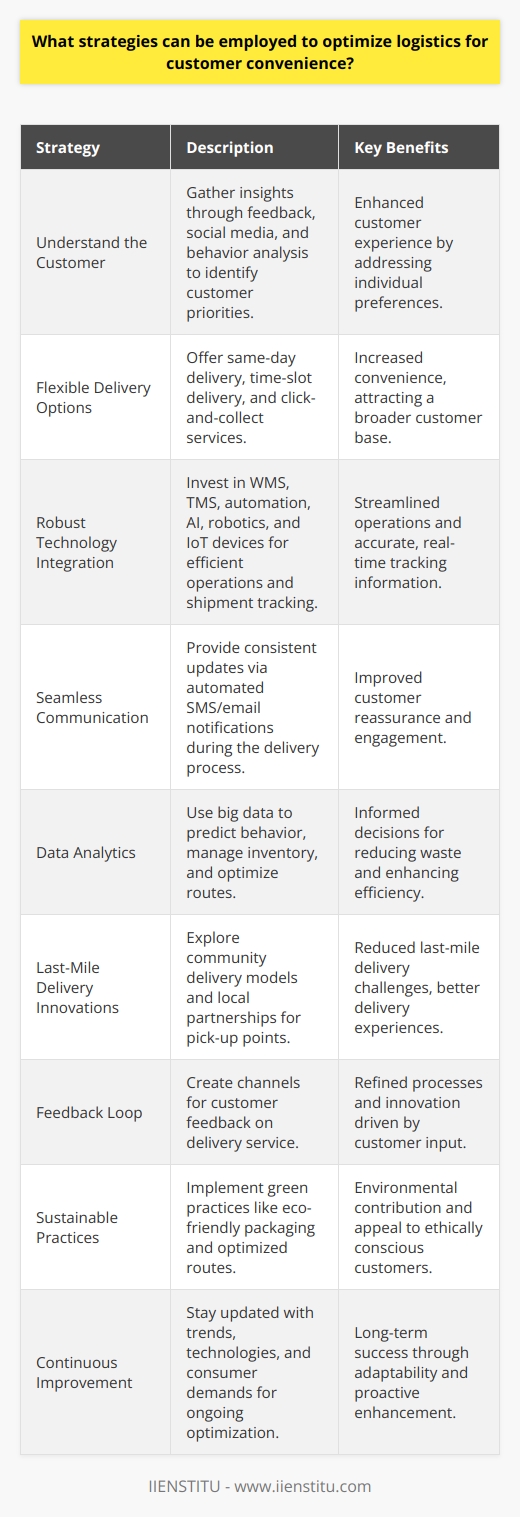
How can businesses identify and address the barriers to order convenience?
Order convenience is a key factor in the success of any business. Customers expect convenience when ordering products or services, and businesses must be able to meet these expectations to remain competitive. The challenge for businesses is identifying and addressing the barriers to order convenience.
The first step in identifying the barriers to order convenience is to analyze the customer experience. This can be done through customer surveys, interviews, focus groups, or other methods. This analysis should assess the customer’s experience when placing an order, including the ease of use of the ordering process, the availability of payment options, and the speed of delivery.
Once the barriers to order convenience have been identified, businesses can develop strategies to address these issues. One approach is to simplify the ordering process. This could involve streamlining the ordering process by reducing the number of steps required to place an order, providing clear instructions for completing orders or using technology to automate the ordering process.
Another way to address barriers to order convenience is to offer various payment options. Customers should be able to choose the payment method that suits them best, whether it is a credit card, PayPal, or another payment method. Offering multiple payment options can also help to reduce customer frustration and improve customer satisfaction.
Finally, businesses should strive to deliver orders quickly and efficiently. This can be achieved by optimizing delivery routes, utilizing third-party delivery services, or providing customers with tracking numbers to monitor their orders' progress.
In conclusion, businesses must identify and address the barriers to order convenience to remain competitive in the marketplace. This can be achieved by analyzing the customer experience, simplifying the ordering process, offering various payment options, and optimizing delivery routes. Businesses can improve customer satisfaction and increase their profits by addressing these barriers.
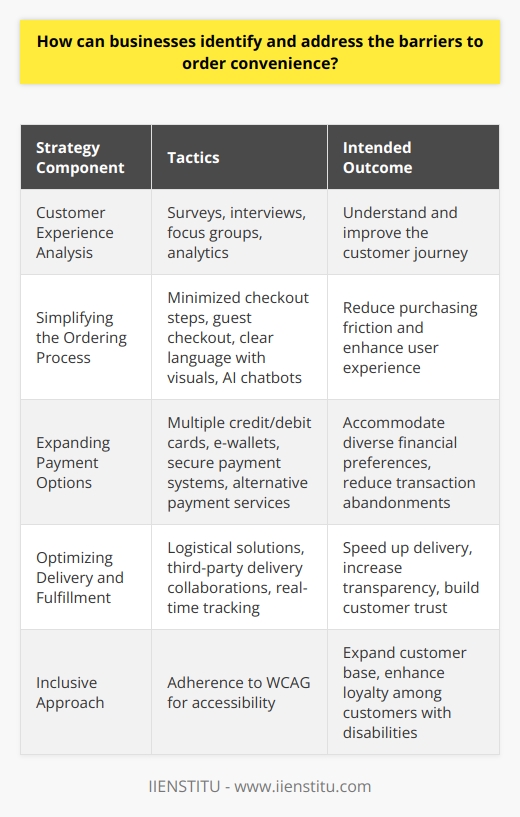
What are the potential impacts of order convenience on customer satisfaction?
Amid the emergence of e-commerce and online retailing in the modern marketplace, order convenience is becoming increasingly crucial for businesses to retain and maintain customer satisfaction. Order convenience can increase customer satisfaction in numerous ways, including providing customers with quick and straightforward ordering processes, efficient delivery methods, and various payment options.
One of the most prominent potential impacts of order convenience on customer satisfaction is the ease of ordering. By providing customers with a straightforward online ordering system, businesses can reduce the stress associated with ordering products or services. Customers can also make their selections more quickly as they do not need to enter their details manually. This quick and efficient ordering process allows businesses to serve their customers better and provide them with a satisfactory experience.
Furthermore, order convenience can also increase customer satisfaction by providing customers with various delivery methods. As customers increasingly expect fast delivery times, businesses can utilize order convenience to provide customers with various delivery options that meet their needs. This can include allowing customers to select express delivery or pick up their order in-store. By offering customers a range of delivery methods, businesses can ensure they can provide their customers with a satisfactory delivery experience.
Finally, order convenience also impacts customer satisfaction by providing customers with various payment options. By offering customers a variety of payment methods, businesses can increase customer satisfaction by making it easier for them to make payments. This can include offering customers the option to pay via credit card, PayPal, or even a mobile payment app. This can make it easier for customers to make payments and provide them with a more satisfactory experience.
In conclusion, order convenience has the potential to impact customer satisfaction significantly. By providing customers with a straightforward ordering process, a range of delivery methods, and various payment options, businesses can increase customer satisfaction and ensure they can provide their customers with a satisfactory experience.

How do you optimize logistic processes to enhance customer experiences?
Logistics as a Key Factor in Customer Experience
To optimize logistic processes and enhance customer experiences, a comprehensive evaluation of the existing supply chain is essential. This assessment will identify bottlenecks and inefficiencies, allowing for targeted improvements.
Utilizing Technology for Seamless Integration
A crucial step in optimizing logistics is implementing advanced technology for data management and automation. This includes employing warehouse management systems (WMS), transportation management systems (TMS), and customer relationship management (CRM) software. These tools facilitate seamless integration and provide real-time insights into inventory, delivery and customer satisfaction.
Improving Speed and Accuracy in Order Fulfillment
Faster, more accurate order fulfillment is a proven method to achieve customer satisfaction. Utilizing technologies like barcode scanners, automated storage and retrieval systems (AS/RS), and robotics, companies can expedite order processing and reduce errors. Efficient picking, packing, and shipping processes ensure that customers receive their orders promptly and accurately.
Adopting Flexible Delivery Options
Customer preferences for delivery are ever-evolving. To cater to these needs, businesses must offer flexible delivery options like next-day and same-day deliveries or scheduled pickups. Building strong networks of carriers, optimizing route planning, and using technology solutions for tracking can aid in providing these flexible options.
Actively Engaging with Customers
Effective communication plays a vital role in customer satisfaction. Businesses should provide customers with real-time updates on order status, expected delivery times, and notifications on any potential delays. Proactively addressing inquiries and resolving issues can prevent customer dissatisfaction and maintain a positive brand image.
Continuous Improvement through Feedback
Lastly, businesses should prioritize soliciting customer feedback and using this information for continuous improvement. Analyzing customer reviews can identify pain points in the logistics process and help to implement appropriate corrective measures. Such a feedback loop will lead to a more refined logistics process and enhanced customer experiences.
In conclusion, optimizing logistic processes involves utilizing technology for seamless integration, enhancing speed and accuracy in order fulfillment, providing flexible delivery options, engaging actively with customers, and consistently seeking feedback for improvements. By prioritizing these aspects, businesses can significantly enhance their customer experiences and maintain a competitive edge in the market.
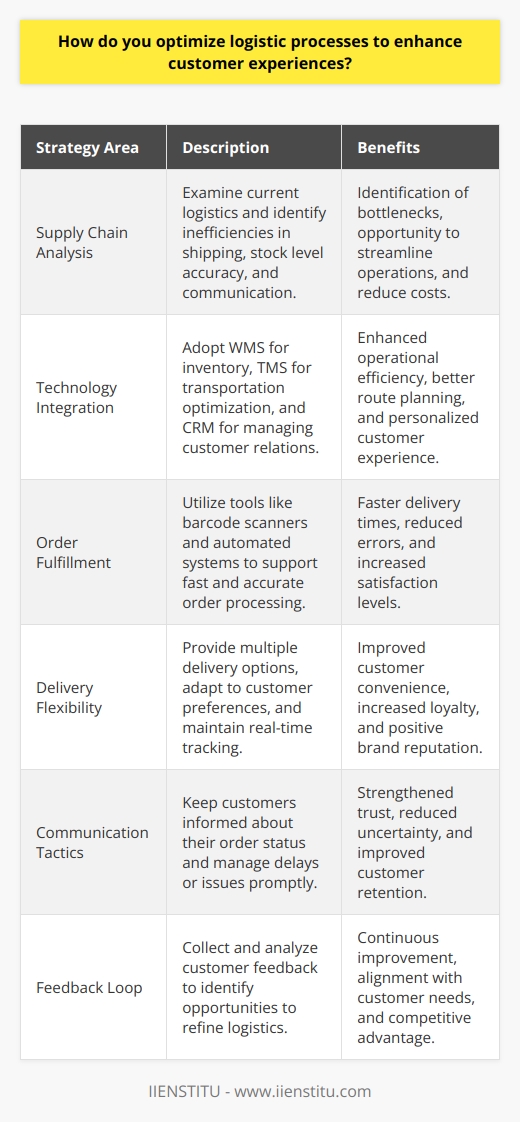
What are the key elements of the 7 R's of customer service in logistics and their impact on customer satisfaction?
Key Elements of the 7 R's
The Right Product
One of the key elements of customer service in logistics is offering the right products to meet customers' needs. This involves providing a wide range of options, understanding customer preferences, and stocking items that are in high demand. Ensuring customers receive the correct product contributes greatly to their satisfaction.
The Right Quantity
Another essential aspect of customer service in logistics is providing the right quantity of products. Customers should not have to deal with overstocking or understocking issues. Proper inventory management contributes to customer satisfaction by meeting their demand and minimizing waste.
The Right Condition
Maintaining products in the right condition is critical for customer satisfaction. This includes ensuring that items are not damaged during transportation, storage, or delivery. Proper packaging and handling practices contribute to upholding the quality and condition of products.
The Right Place
Customer satisfaction can be significantly impacted by the availability of products at the right place. Logistics providers must consider customers' location when designing and implementing distribution networks, ensuring products are conveniently accessible for customers.
The Right Time
Timely delivery is essential in meeting customer expectations. Logistics providers must ensure accurate and prompt delivery of products to maintain credibility and enhance customer satisfaction. This includes efficient transportation networks and optimized routing.
The Right Cost
Pricing can have a significant impact on customer satisfaction within the logistics industry. Ensuring that shipping and handling fees are competitive and reflect the quality of service plays a vital role in maintaining customer loyalty and satisfaction.
The Right Customer
Lastly, proper targeting of customers is a critical element in ensuring satisfaction. Logistics providers should identify their target customer base and focus on fulfilling their specific needs through careful market analysis and segmentation.
In conclusion, the 7 R's of customer service in logistics play a crucial role in enhancing customer satisfaction. By focusing on these key elements, logistics providers can ensure that they are meeting their customers' expectations and delivering a high standard of service.
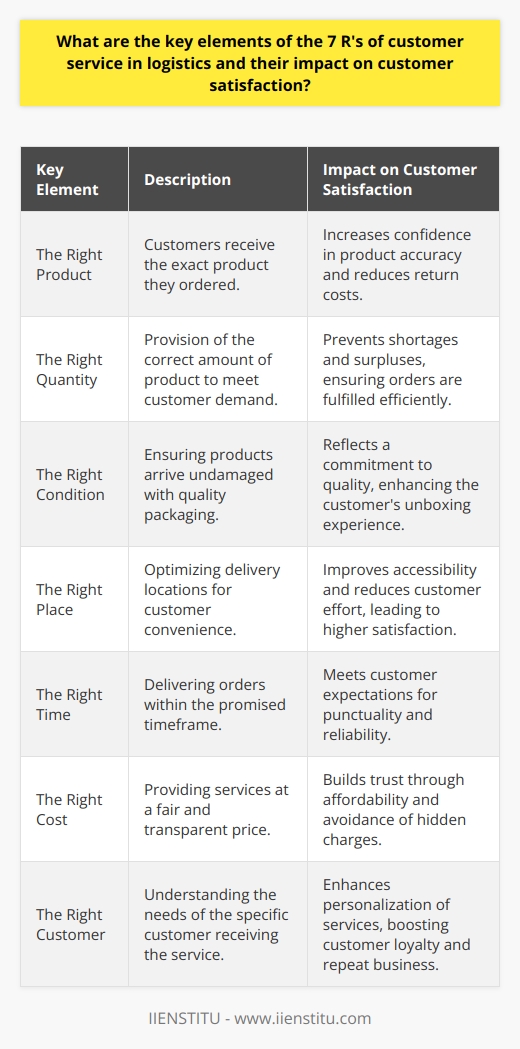
How can logistics activities be tailored to optimize customer satisfaction and build long-lasting relationships?
Understanding Customer Preferences
To optimize customer satisfaction and build long-lasting relationships, logistic activities must be tailored based on a deep understanding of customer preferences. Companies need to analyze data regarding common customer preferences, such as delivery speed, tracking visibility, and preferred communication channels. Leveraging this information allows businesses to prioritize essential aspects of their logistics operations that directly impact customer satisfaction.
Personalized Delivery Options
Offering personalized delivery options plays a crucial role in enhancing customer satisfaction. Tailoring logistic activities to include multiple delivery options, such as same-day delivery, next-day delivery, or time-slot selection, enables customers to choose the option that best suits their needs. This flexibility demonstrates a genuine understanding of individual customer requirements and establishes a strong foundation for long-lasting relationships.
Proactive Communication and Transparency
Effective communication is essential in the context of logistics, which directly impacts customer satisfaction. Providing proactive updates on shipment and delivery status, addressing customer queries promptly, and maintaining transparency in the shipping process contribute significantly to customer satisfaction. Integration of technology, such as real-time tracking and automated notifications, can facilitate effortless communication between the company and its customers.
Efficient Issue Resolution
Efficiently resolving issues related to logistics can profoundly impact customer satisfaction levels. By actively addressing customer complaints related to delayed deliveries, damaged products, or inaccurate deliveries, businesses strengthen their relationships with customers. Implementing a robust complaint management framework that ensures timely issue resolution is key to this effort.
Fostering Sustainability
Increasingly, customers value sustainable practices in various business aspects, including logistics. Adopting environmentally friendly strategies, such as using recyclable packaging materials, consolidating shipments, and deploying fuel-efficient transportation modes, can enhance customer satisfaction. Demonstrating a commitment to sustainable logistics activities conveys a sense of responsibility towards the environment and influences customer perception positively.
In conclusion, tailoring logistics activities based on customer preferences, providing personalized delivery options, maintaining transparent communication, efficiently resolving issues, and prioritizing sustainability can significantly optimize customer satisfaction and build long-lasting relationships. By integrating these strategies, companies can ensure that their logistical operations support their overall objectives of fostering loyalty and enhancing the customer experience.
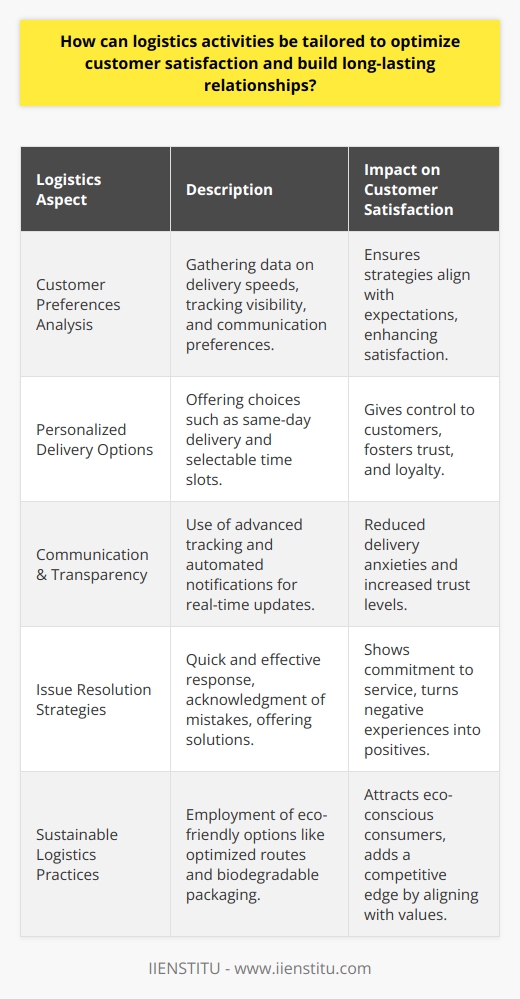
How can value creation through logistics processes contribute to improved customer experiences?
Value Creation in Logistics Processes
Effective logistics processes can significantly contribute to value creation, which ultimately leads to improved customer experiences. By streamlining distribution channels, optimizing inventory management, and enhancing transportation efficiency, logistics processes can add immense value to a business.
Efficient Distribution Channels
The first step to creating value through logistics processes is optimizing distribution channels. By establishing a seamless flow of goods and ensuring timely product delivery, companies can enhance the overall customer experience, leading to increased customer satisfaction and loyalty.
Optimal Inventory Management
Inventory management plays a crucial role in value creation by reducing storage costs, obsolescence risks, and stockouts. An optimal inventory strategy involves accurate demand forecasting, safety stock calculation, and efficient stock rotation, ensuring that customers have access to the right products at the right time. This enhances the overall shopping experience and promotes customer retention.
Enhanced Transportation Efficiency
Lastly, improving transportation efficiency is critical for value creation in logistics processes. Efficient transportation reduces lead times, guarantees faster deliveries, and minimizes the environmental impact of logistics operations. This not only delights customers by exceeding their expectations but also contributes to a company's sustainability initiatives and reputation.
In conclusion, value creation through logistics processes can vastly improve customer experiences by ensuring efficient distribution channels, optimal inventory management, and enhanced transportation efficiency. These elements work together to create a seamless supply chain that consistently meets customer needs and surpasses their expectations, leading to lasting customer relationships and a competitive advantage in the market.
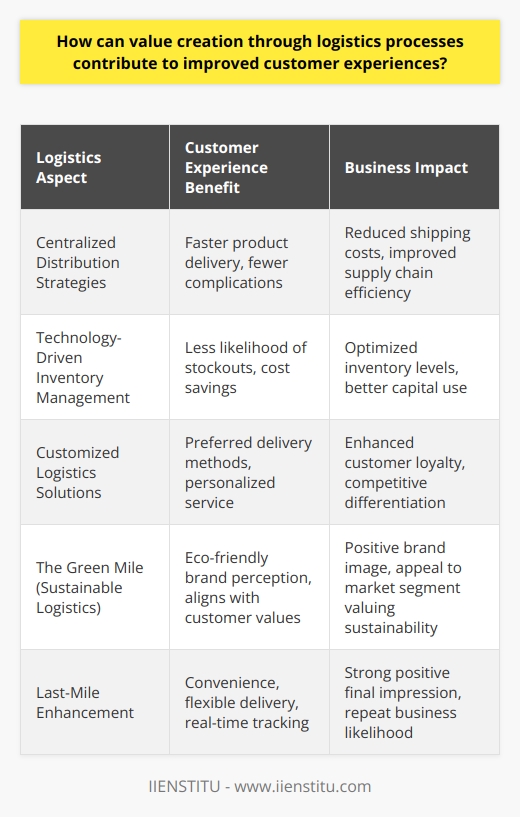
What role does data analysis play in optimizing logistics operations to meet customer expectations?
Role of Data Analysis in Logistics Optimization
Enhancing Decision-Making Process
Data analysis plays a crucial role in streamlining logistics operations by enhancing the decision-making process. By systematically analyzing a vast amount of data, organizations can identify patterns, trends, and correlations that enable them to make informed strategic and operational decisions. This, in turn, allows logistics service providers to optimize their processes, reduce costs, and improve overall performance, ultimately exceeding customer expectations.
Monitoring and Evaluating Performance
Analyses of data help measure the effectiveness of logistics activities and determine areas that require improvement. Through continuous monitoring and evaluation, logistics executives can quickly identify bottlenecks and inefficiencies, enabling them to implement corrective actions or redesign workflow processes to meet customer requirements. This real-time insight into the logistics' performance also helps in managing resources effectively, ensuring timely delivery and optimal service quality.
Predicting and Managing Demand
Data analysis helps logistics companies predict and manage demand by analyzing historical customer data and market trends. It enables organizations to understand customer behavior and preferences, making it easier to develop tailored strategies for addressing their needs. Accurate demand forecasting also allows logistics providers to optimize their inventory levels, transportation capacities, and distribution networks, ensuring the timely and efficient fulfillment of customer orders.
Reducing Costs and Increasing Profitability
By identifying inefficiencies and areas with high operating costs, data analysis directs resources to optimal allocation, leading to cost reduction and increased profitability. Implementing advanced data analytics tools also allows logistics providers to assess the long-term impact of their decisions, enabling them to prioritize strategic investments in infrastructure, technology, and skilled workforce. This proactive approach to cost management supports sustaining a competitive edge and meeting customer expectations in a rapidly evolving marketplace.
Enhancing Collaboration and Visibility
Data analysis promotes improved collaboration and visibility across the logistics value chain. By integrating data from various stakeholders, companies gain a holistic view of their supply chain operations, enabling them to identify opportunities for enhancing coordination and reducing redundancies. These insights improve the end-to-end visibility of logistics operations, which translates into better customer service and a more agile response to market fluctuations.
In conclusion, data analysis is an essential tool in optimizing logistics operations to meet customer expectations. It supports informed decision-making, enhanced performance management, accurate demand forecasting, effective cost reduction, and increased collaboration and visibility. By embracing data-driven insights, logistics providers can significantly improve their service quality and maintain a competitive edge in a dynamic global marketplace.
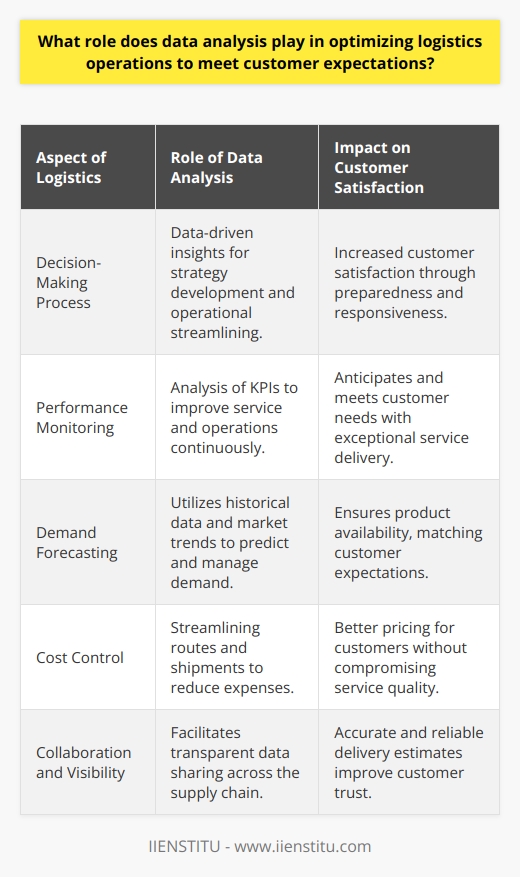
In what ways can logistics optimization contribute to sustainable and environmentally-friendly practices?
Reducing Environmental Impact Through Transportation
Logistics optimization can significantly contribute to sustainable and environmentally-friendly practices by reducing the environmental impact of transportation. By streamlining transportation routes and reducing the distance traveled, fuel consumption and CO2 emissions are minimized. This can be achieved by utilizing advanced routing software, which analyzes data to create the most efficient routes, further decreasing travel time and idling periods.
Energy-Efficient Warehousing Techniques
Environmentally-friendly practices can also be promoted through the optimization of warehousing operations. Implementing energy-efficient techniques, such as the use of renewable energy sources, smart lighting systems, and proper insulation, helps to reduce a facility's energy consumption. Additionally, designing warehouses with space optimization in mind allows for more efficient storage and movement of goods, reducing the need for additional resources and promoting a reduction of waste.
Promoting Sustainable Packaging Solutions
Another way logistics optimization can contribute to environmentally-friendly practices is by incorporating sustainable packaging solutions. By using materials that are recyclable or biodegradable, the amount of waste generated during transportation is reduced. This also encourages companies to design packages that minimize the use of materials while still protecting the integrity of the goods inside. Furthermore, evaluating shipment sizes and consolidating orders can lead to a decrease in packaging materials needed and a reduction in the number of shipments required, further decreasing environmental impact.
Green Procurement and Supplier Selection
Incorporating green procurement strategies into logistics optimization is another method of promoting sustainability. By selecting suppliers who implement environmentally-friendly practices in their production processes, companies can indirectly reduce the overall environmental footprint of their supply chain. Green procurement includes assessing factors such as energy consumption, waste management, and emission levels of potential suppliers, ensuring that the selection process aligns with sustainability goals.
Implementing Reverse Logistics Strategies
Lastly, the inclusion of reverse logistics in optimization efforts can improve sustainability and environmental impact. Reverse logistics involves the collection and recycling of products or materials that have reached the end of their lifecycle. By establishing programs that encourage the return of used items and repurposing or recycling materials, companies can reduce waste production and promote a circular economy. This ultimately leads to a more environmentally-friendly and sustainable supply chain.
In conclusion, logistics optimization plays a crucial role in the facilitation of sustainable and environmentally-friendly practices. By focusing on transportation efficiency, energy-efficient warehousing, sustainable packaging solutions, green procurement, and implementing reverse logistics strategies, companies can significantly reduce their environmental impact and contribute to a more sustainable future.
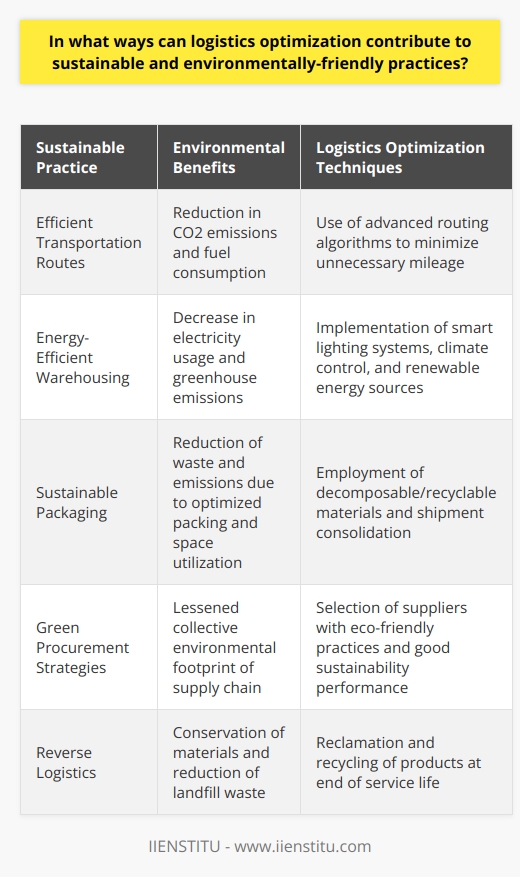
What are the implications of implementing the 7 R's of customer service in logistics for organizational performance and customer retention?
Organizational Performance Enhancement
Implementation of the 7 R's of customer service in logistics significantly influences an organization's performance. It is because these principles align with customer expectations and enable quick resolutions to service issues. This alignment enhances service efficiency, fosters goodwill, and promotes brand reputation.
Improved Efficiency
Efficient processes result from the proper management of logistics using the seven R's framework. They involve the right product, quantity, condition, place, customer, cost, and time. These elements streamline operations, reduce waste, and increase productivity. Implementing these also ensures accurate delivery, minimizing costly returns and exchanges.
Customer Retention Strategies
Customer retention benefits from the 7 R's implementation. The right goods, meeting customer expectations promote customer satisfaction, leading to greater brand loyalty. Once customers trust a brand's competency to deliver as promised, they tend to stay with that brand. This loyalty equates to repeated purchases, thus securing a steady revenue stream.
Brand Reputation and Goodwill
Successful implementation of the 7 R's contributes to a brand’s reputation and goodwill. Meeting customers’ expectations consistently enhances a company's image and value. A reputation for reliable service, in turn, attracts more customers and inspires loyalty among existing ones. Therefore, increased goodwill comes as a positive outcome of these strategies.
In conclusion, incorporating the 7 R's in logistics enhances organizational performance by streamlining operations and improving service delivery. Resultantly, organizations enjoy increased customer retention and a boost in goodwill. These factors contribute to a comprehensive positive impact on the organization's overall performance.
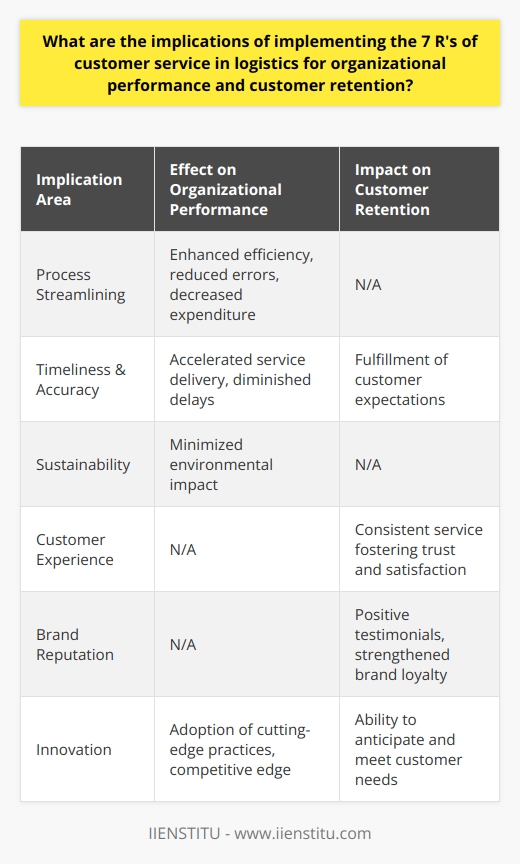
How can advanced technologies, such as automation and artificial intelligence, be utilized to optimize logistics operations and maximize customer satisfaction?
Optimization through Automation and AI
Advanced technologies such as automation and artificial intelligence (AI) hold significant potential for optimizing logistics operations. These technological innovations can streamline tasks, for example, inventory management, reducing labor costs and human error.
Improved Operational Efficiency
Automation aids in achieving timely and accurate deliveries. Automated systems can efficiently control warehousing procedures and transport arrangements. This technology ensures the proper distribution of goods and lessens delays that can result in customer dissatisfaction. Moreover, automation eliminates the potential for human-made errors, increasing the reliability of the operations.
AI for Forecasting and Planning
AI, on the other hand, plays a crucial role in supply chain forecasting and planning. Through machine learning algorithms, AI can analyze past data, predict trends, and help businesses make informed decisions about stock management. AI can forecast supply and demand more accurately, preventing overstock problems and ensuring that products meet consumer demand.
Maximizing Customer Satisfaction
These advancements also contribute significantly to enhancing customer satisfaction. Automation can ensure consistent, timely deliveries, while AI can allow customization of services. AI technology can process and analyze customer data to give a personalized experience. For example, AI can suggest products based on previous buying behavior, enhancing the shopping experience and boosting customer satisfaction.
AI and Human Collaboration in Customer Service
In customer service, AI-powered chatbots can provide immediate responses to customer queries. Although unable to replace human interaction entirely, chatbots can handle simple inquiries, freeing up staff to deal with more complex issues. This blend of automation and human interaction strives to create the ideal customer experience.
In summary, advanced technologies such as automation and AI can optimize logistics operations, reduce costs, improve efficiency, and enhance customer satisfaction. By harnessing these innovations, businesses will be better equipped to navigate the rapidly evolving logistics landscape.
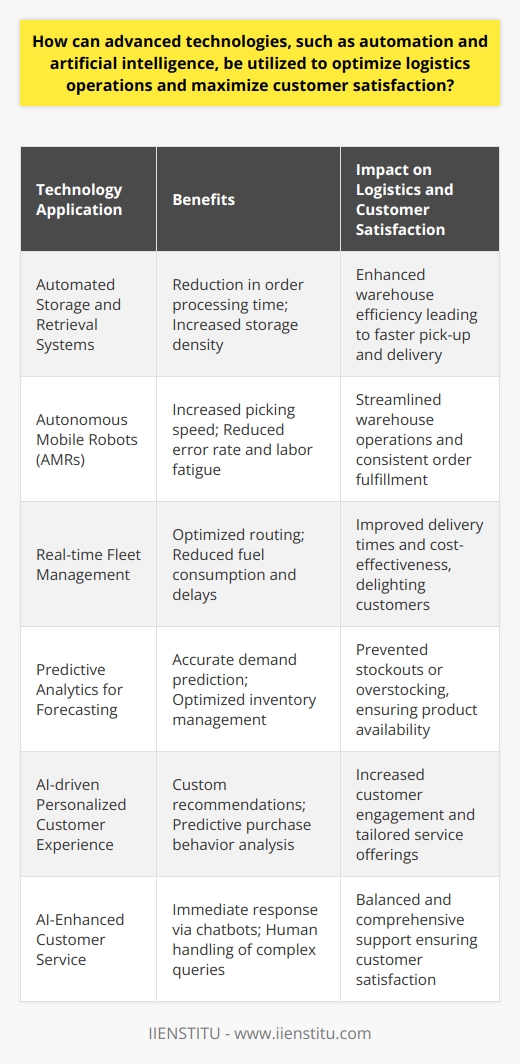
What role does supply chain management play in optimizing logistics processes to fulfill customer expectations and enhance overall customer experience?
Role in Optimizing Logistics
Supply chain management (SCM) serves a crucial function in optimizing logistics processes. Its primary role includes controlling and managing the flow of goods and services within a company. An effective supply chain management system ensures that the products efficiently move from production to the end consumer.
Achieving Customer Expectations
SCM contributes significantly to fulfilling customer expectations. Its effective planning and execution provide accurate and prompt delivery, which is a primary customer expectation. Timely delivery enhances the customers' overall experience, thereby influencing their loyalty and repeat purchasing behavior.
Benefits of Efficient Supply Chain Management
Supply Chain Management reduces operational costs by eliminating inefficiencies and bottlenecks in logistics. It brings down unnecessary holding costs and the risk of obsolete inventory. Resources optimize better, leading to increased productivity. An efficient SCM results in higher profit margins.
Implication on Customer Experience
Enhanced customer experience is another advantage of efficient supply chain management. Customers prefer businesses that deliver superior service levels, especially prompt and accurate deliveries. SCM achieves this by ensuring that companies keep up with demand, avoiding stock-outs and delays.
Importance of Flexibility in SCM
Flexibility in SCM is critical to meet diverse customer needs. The flexibility to tweak operations based on customer requirements allows companies to tailor their service delivery to match customer expectations. This results in a personalized customer experience and eventually leads to customer satisfaction.
In conclusion, supply chain management plays a vital role in optimizing logistics processes to fulfill customer expectations and enhance the overall customer experience. It helps businesses to coordinate operations better, leading to improved service levels and higher customer satisfaction. It forms the backbone of any successful logistics operation and is central to enhancing the overall customer experience.
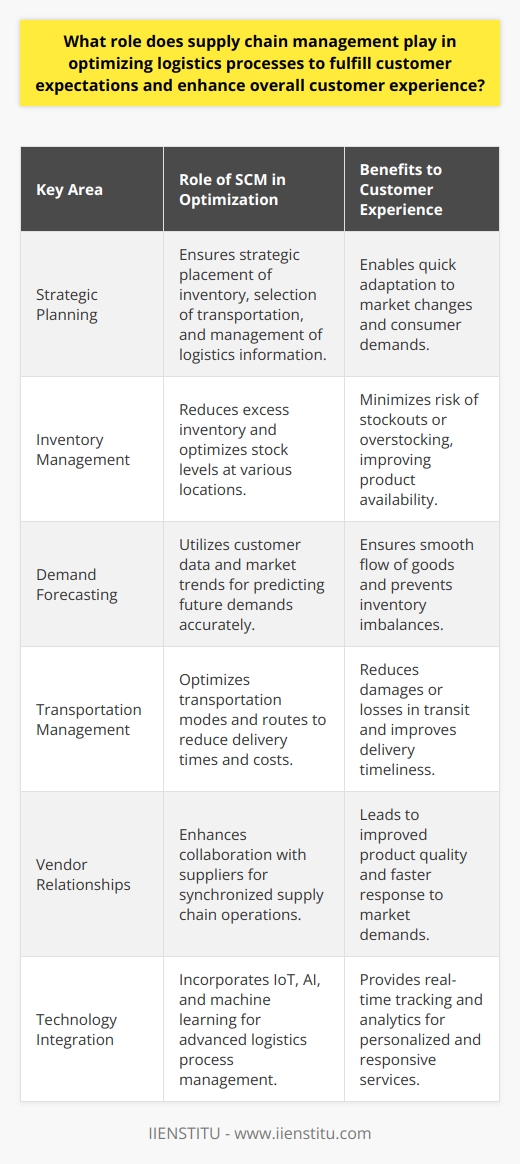
How do you optimize logistics to ensure cost-effectiveness while maintaining efficient delivery times?
Improving Route Planning
To optimize logistics for cost-effectiveness and efficiency, improve route planning. Use advanced route planning software to minimize distances traveled. This software uses algorithms to find the most efficient routes. This reduction in travel distances results in lower fuel costs, less vehicle wear, and faster delivery times.
Investing in Warehouse Management Systems
Invest in modern warehouse management systems (WMS). A proficient WMS enhances inventory accuracy and order fulfillment speed. It speeds up the order picking process while reducing order errors. It also minimizes the need for expensive emergency deliveries due to incorrect orders.
Enhancing Supply Chain Visibility
Don't overlook the importance of supply chain visibility. An efficient supply chain has fully traceable and visible systems. Having access to real-time information about shipments can lead to proactive decisions. These actions can mitigate potential issues affecting cost-effectiveness and delivery times.
Cultivating Strong Supplier Relationships
Cultivate strong relationships with suppliers. A positive relationship ensures their commitment to your success. Solid relationships often translate into better prices and reliable delivery schedules. It also provides room for negotiations, which can benefit cost-effectiveness.
Training Logistics Employees
Well-trained logistics employees are instrumental in maintaining efficient delivery times. Regular training programs help them stay updated on the latest logistics management strategies. It equips them with the knowledge to take swift and effective action when logistics issues arise.
In conclusion, logistical optimization isn't a one-off task. It's an ongoing process involving route planning, investing in efficient systems, and training employees. Establishing strong supplier relationships and supply chain visibility also contribute significantly. By taking these steps, it's possible to maintain cost-effectiveness and efficient delivery times in logistics.

How can organizations leverage advanced analytics in optimizing logistics operations for greater customer value?
Utilization of Advanced Analytics
Organizations can optimize their logistics operations and augment customer value through the strategic application of advanced analytics. Data analytics tools can examine and interpret extensive datasets to glean insights which contemporary methods may overlook.
Incorporating Predictive Analytics
By incorporating predictive analytics, businesses can anticipate customer demands, enabling them to adjust stock levels and logistical response accordingly. This method utilizes historical data and identifies patterns. Forecasting demand accurately prevents stock shortages and excesses, thereby optimizing warehouse management and increasing customer satisfaction.
Real-time Analytics for Decision Making
Real-time analytics can enhance decision-making processes in logistics. It allows organizations to track and monitor goods, preserving optimum inventory levels. This monitoring significantly reduces delays, giving customers accurate delivery information, and improving their overall experience.
Enhancing Route Optimization
Another application is in enhancing route optimization. Advanced analytics can identify the most efficient delivery routes, considering factors such as traffic conditions and distance. Optimized routes lead to timely deliveries, reducing costs and amplifying customer satisfaction.
Strategic Resource Management
In resource management, analytics can align the allocation of resources with demand, ensuring maximal efficiency. By identifying patterns and trends in usage data, organizations can deploy resources where they are most needed, increasing operational efficiency and customer value simultaneously.
In conclusion, advanced analytics offers manifold opportunities for businesses to optimize their logistical operations. Through predictive analysis, real-time monitoring, route optimization, and strategic resource management, businesses can significantly enhance efficiencies, reduce costs, and deliver superior customer value.
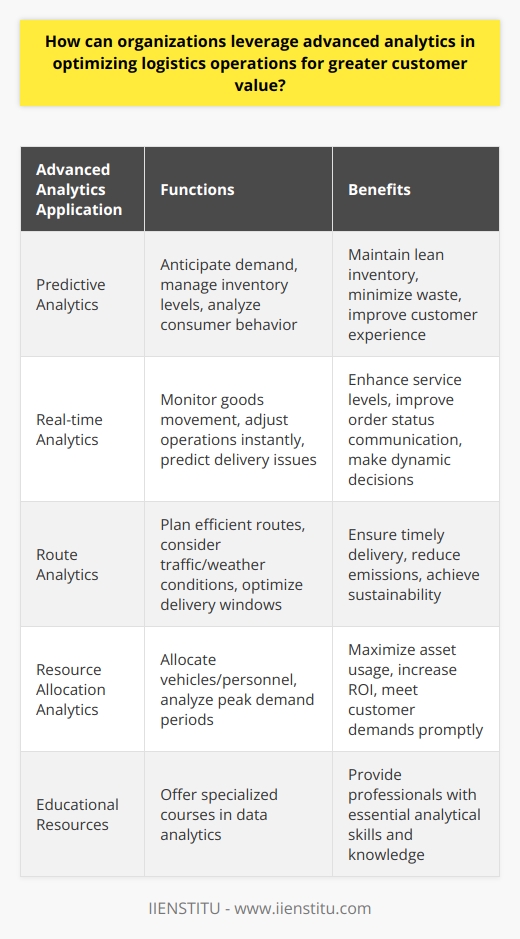
What role does collaboration among various stakeholders in the supply chain play in optimizing logistics operations to meet customer demands and expectations?
Role of Collaboration in Optimizing Operations
Collaboration within the supply chain plays a crucial role in optimizing logistics operations. It facilitates a streamlined flow of goods, services, and information from the point of origin to end-users.
Promotion of Operational Efficiency
Stakeholders’ collaboration encourages operational efficiency. It provides an effective platform for sharing resources and information, minimizing waste and reducing costs. By promoting harmonized operational methods, it encourages a unified approach towards goal achievement.
Enhanced Decision-Making Processes
Collaboration fosters improved decision-making and problem-solving processes. A collective approach allows stakeholders to share insights, resulting in more informed decisions that effectively address customer demands and expectations.
Fostering Innovation and Improvement
Through collaboration, a conducive environment for innovation is fostered. Various stakeholders can share ideas, giving birth to innovative solutions that enhance logistics operations in response to changing customer needs.
Mitigation of Supply Chain Risks
Collaboration aids in risk mitigation. Stakeholders can jointly develop strategies to address foreseeable risks, ensuring business continuity and dependability in delivering goods and services to customers.
Customer Satisfaction
Stakeholder collaboration directly impacts customer satisfaction. An efficient supply chain ensures timely delivery of quality goods and services that meet or exceed customer expectations.
In conclusion, collaboration among various stakeholders in the supply chain is indispensable in optimizing logistics operations. While enhancing operational efficiency and decision-making processes, it also fosters innovation, mitigates risks, and enhances customer satisfaction. Thus, continuous efforts should be placed on fostering and sustaining collaboration among all supply chain stakeholders.

